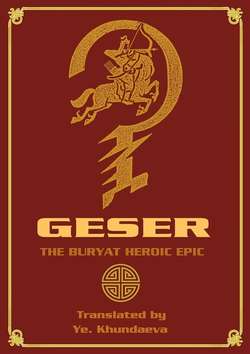Geser. The Вuryat heroic epic

Реклама. ООО «ЛитРес», ИНН: 7719571260.
Оглавление
Ye. Khundaeva. Geser. The Вuryat heroic epic
Preface
Part 1. The buryat heroic epic “Geser”
The Buryat heroic epic of Geser: the general characteristics
On the study of the “Geser” heroic epic
А brief summary of the contents of Geser
The Image of Nature in the Buryat heroic epic
The natural phenomena and the epical heroes
The golden proportion in the Buryat Geseriade
The religious cults and rituals
The everyday traditions and customs
A brief summary of the translating methods
The Geseriade as part of the world culture
“Geser” and the Anglo-Saxon epopee “Beowolf”
The written story of Geser in the Old Mongolian script
Part 2. Abai Geser the mighty
1
2
3
4
5
6
7
8
9
10
11
12
13
14
15
16
17
18
19
20
The commentary
Отрывок из книги
The book contains the text of the translation to the English language of the unique epical monument of the Buryat people “Abai Geser the Mighty” written down from one of the gifted Buryat epic-tellers Manshud Imegenov by an outstanding expert of the Buryat folklore Ts. Jamtsarano. Consideration is given to the general characteristics and contents, the epical heroes, the cults and rituals, the traditions and customs, the natural phenomena and some other issues. It is argued that the rudiments or the first lines that gave the beginning to the text of the present “Geser” epic appeared in the earlier times when there were no religions, there were only some cults and beliefs wholly based on the observations of the natural phenomena. The author of the epic “Geser” is the common folk known as the Buryats. The hints concerning the religions were incorporated in the text much later. The manuscripts and block-prints in the Old-Mongolian script are briefly discussed.
The book is intended for the experts in folklore, literature, cultural and religious studies, ethnography and all those interested in the spiritual culture of the Buryat people.
.....
The performing of the “Geser” epic was of ritual, magic, shamanic nature. The epic-tellers sank into trance when performing the epic. The epic was used by the shamans for exorcising the evil spirits. This is reflected in the shaman practice, in the invocations. Geser is taken to be the son of the Tengri (Heaven). Sometimes the Earth and Water are regarded as Geser’s parents, this fact is associated with the shaman ideas of the human personification of the souls of the mountains and localities. Reciting of the uliger appeases the spirit of the Master of the taiga (thick forest) and helps in hunting. A folklore performer himself was in fact a shaman or is now a peculiar type of shaman.
According to the epic the people are deeply affected by the natural phenomena. To be more exact, this all reminds of some of the features and deeds of the main character of the Buryat epopee “Geser”. He gives an impression of being quite often an emotional and caring personality in his attitude to his family, relatives, kinsmen, motherland and nature. All his deeds are closely connected with the natural forces and phenomena. The heroic epic of the Buryat people narrates of the noble deeds of Geser liberating the people from the evil, of his battles with the monsters that would not let people live in peace and harmony. Not infrequently those monsters-mangadkhais personified the powerful, threatening forces of Nature that were beyond understanding of the common folk. They were quite unaware of the origin and the cause for their being sometimes quite merciless. Therefore those powerful forces were taken as, say, Gal-Nurman Khan who was the symbol of one of the prime elements, i.e. the Fire, the oppressive heat and drought. One might recall Loir Lobsogoldoi who was the personification of another prime element, i.e. the water, flood and overflow that badly damaged and injured the people, animals and plants. One could add here monster Orgoli who was taken as Master of the taiga (thick forests) and could deprive hunters of their game or sometimes took up their lives. Then there was Shereem Minata khan with an iron whip and a pig iron thigh who possibly symbolized the starting point of the blacksmith shop, the first steps in mastering the art of forging. The sparks and flames coming from the glowing metal were perceived by the ancient forefathers of the Buryats as a threatening iron whip which might burn or dazzle. One might as well recall the epical devil Arkhan who wanted to swallow the Sun and the Moon and plunge the Earth into the darkness. This might be the symbolical representation of the Sun and the Moon eclipse in the perception of the ancient Buryats.
.....